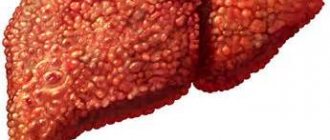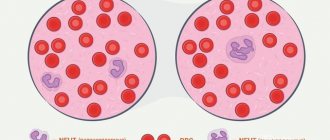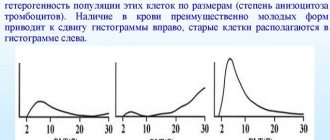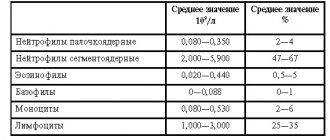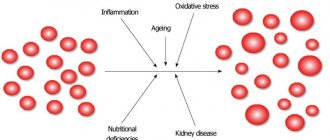Synonyms: Urea in urine, Urea
Urea - a carbonic acid amide, a nitrogen-containing product of protein metabolism - is formed in the liver and excreted from the body in the urine. A change in urea concentration in one direction or another may indicate an imbalance in the nitrogen balance and, as a result, the presence of a number of diseases (mainly kidneys and gastrointestinal tract organs). An analysis for urea in urine allows us to evaluate the process of protein synthesis and breakdown , as well as carry out differential (comparative) diagnosis of kidney pathologies from liver diseases.
As a result of successive biochemical processes (urea cycle), occurring with the participation of special enzymes, water-soluble and slightly toxic urea is formed in the liver, which is excreted in the urine. Its volume accounts for up to 90% of all products of protein metabolism.
Nitrogen balance
The concentration of urea in urine directly depends on the amount of protein entering the body with food. This is the nitrogen balance, which normally corresponds to 500 mmol (14 g) of urea per 100 g of protein consumed in an adult.
Negative
With a negative nitrogen balance, an increase in the concentration of urea in the urine is observed. This condition is typical for the postoperative and post-traumatic period, pathologies of the thyroid gland (hyperfunction), impaired absorption of amino acids and proteins in the intestine as a result of internal bleeding from the upper gastrointestinal tract.
Positive
If a small amount of urea is excreted in the urine, then the nitrogen balance is regarded as positive. In this case, kidney and/or liver dysfunction may be suspected. Also, a decrease in urea concentration is provoked by hormonal drugs. In rare cases, a hereditary pathology is observed when, due to congenital enzymatic deficiency, the synthesis of urea slows down or stops altogether.
A decrease in urea excretion (secretion) is also recorded in the case of:
- increased passive reabsorption (2nd phase of urine formation) in the renal tubules;
- severe dehydration or intoxication of the body;
- hypovolemia (reduction in circulating blood volume);
- circulatory disorders in the kidneys due to massive burns, heavy bleeding, shock, heart failure, etc.;
- weakening of renal blood flow in elderly patients with atherosclerosis (deposition of cholesterol plaques) of the renal arteries.
Urine analysis for urea content allows us to evaluate the process of protein metabolism in critically ill patients in intensive care. It is especially important to determine the nitrogen balance in those patients who receive tube or parenteral (outside the gastric tract) nutrition, which makes it possible to most accurately determine the dosage of the supplied protein drugs.
It is also necessary to establish the exact concentration of urea in the urine if its level in the blood is elevated. This will allow a comprehensive assessment of the functioning of the excretory system in general and the kidneys in particular.
Indications
- Deviation from the norm in the results of the test for urea in the blood;
- Assessment of nitrogen balance and all processes of protein synthesis/breakdown in the body;
- Determination of the exact amount of protein preparations for seriously ill patients receiving tube feeding;
- Identification of disturbances in the functioning of the excretory system;
- Diagnosis of kidney diseases: renal failure;
- pyelonephritis;
- amyloidosis;
- glomerulonephritis;
- kidney tuberculosis, etc.;
The results of the analysis for urea in urine can be interpreted by a nephrologist, urologist, resuscitator, gastroenterologist, therapist, surgeon, family doctor, pediatrician, etc.
Detailed description of the study
Protein is the main biochemical component of the human body, the basis of which is amino acids consisting of nitrogen, carbon, oxygen and hydrogen. Normally, protein metabolism is closely related to the liver, where their formation and breakdown, or deamination, occurs. The latter process is represented by a cascade of reactions, as a result of which urea is formed.
Urea, or carbamide, is the end product of protein metabolism, formed from ammonia, which is toxic to humans. Urea is the main nitrogen-containing substance in the body - it contains about 90% of the nitrogen from all broken down proteins. After formation in the liver, urea enters the blood, as well as other liquid media, and is excreted by the kidneys along with urine.
In the kidneys, urea, together with creatinine (the end product of metabolism in muscles), goes through the stages of filtration and reabsorption - reabsorption into the blood. Normally, most of the urea is excreted from the body through urine. The level of urea depends on the nature of the diet - the more protein food in the diet, the more it is formed and excreted. The reasons for the increase in urea can also include: a feverish state, strong physical exertion, the postoperative period, as well as taking hormonal drugs (thyroid hormones, adrenal glands) or increased activity of the hormones of these organs.
Also, the level of urea (in blood and urine) changes with kidney pathology, especially if the filtration process is disrupted, and liver - against the background of severe diseases in which liver cells cannot convert toxic ammonia into safe urea. In diseases that occur with renal failure, there is an increased level of urea in the blood and a decreased level in the urine. When the liver is damaged, urea decreases in both the blood and urine. Extreme renal failure, or uremia, is accompanied by a multiple increase in the level of urea in the blood and, if not properly treated, can lead to serious consequences.
The study of urea in urine is presented in two forms - in daily urine collected over 24 hours, and in a single portion. The choice of the form of analysis depends on the indications and, as a rule, remains with the attending physician due to the individual characteristics of each patient. It is most informative to take any analysis of urea in urine together with an analysis of urea in the blood, which allows for a more complete assessment of disorders of protein metabolism in the liver or the excretion of urea by the kidneys.
Norms of urea in urine
| Patient age | Indicator, mmol/day |
| 1 year | 10 – 100 |
| 1 – 4 years | 50 – 200 |
| 4 – 8 years | 130 – 280 |
| 8 – 14 years | 200 – 450 |
| 14 years and older | 428 – 714 |
Factors of influence
The following factors may influence the results of the study:
- violation of the diet: diets (including protein and medicinal), fasting, fasting days, fasting, switching to vegetarianism, etc.;
- drug treatment (taking diuretics - diuretics, quinine, hormones, nephrotoxic drugs, anabolic steroids, etc.);
- the presence of impurities in the urine (protein plaques, blood clots, pus, mucus, feces particles, etc.);
- violation of the rules for preparing for analysis (physical activity, drinking alcohol on the eve of urine collection);
- violation of requirements for storage and transportation of biomaterial.
Determination of urea content in urine
Determination of urea content in urine is one of the most important indicators for assessing protein metabolism. An excess of proteins in the body leads to disturbances in the functioning of the liver and kidneys, weight gain and the development of allergic reactions. It is urea that is the end product of protein breakdown.
The amount of urea in urine is taken into account in many laboratory tests, which are interpreted by doctors.
Indications for the study
Determination of urea content in urine is mandatory for patients suffering from acute and chronic diseases of the liver and kidneys, as well as women during pregnancy. This study plays an important role in monitoring the effectiveness of adherence to a therapeutic diet, as well as ongoing therapy for chronic diseases.
The analysis allows you to assess protein balance and identify pathological changes in the early stages. The study is especially relevant when preparing patients for surgery and during resuscitation procedures.
It should be noted that urea is present in the urine of each of us. The norm for a healthy person is 2.5-6.4 mmol/l, for children – 1.8-6.4 mmol/l. A physiological increase in urea levels is observed in people over 60 years of age. In other cases, an increase in urea may be observed during fevers, pernicious anemia, in the postoperative period and with excessive physical exertion.
A decrease in the level of urea in urine is observed during pregnancy, with bleeding and burns, heart and kidney failure, gastrointestinal diseases and tuberculosis.
To obtain the most reliable information about the patient’s health status, it is necessary to conduct a comprehensive examination, including a test for urea content in the blood serum.
Research method
To carry out the analysis, daily urine is used, which is collected by the patient independently. The main research method is enzymatic colorimetric, during which the color intensity of urine is assessed, as well as the method using “dry chemistry” technology. The most common is the quantitative determination of urea using the Borodin method, which involves isolating nitrogen and calculating its volumes. To conduct the study, a special device and reagents are used.
It should be noted that enzymatic methods are quite diverse and numerous and include the hydrolysis of urea and further determination of the concentration of ammonia formed. Determining the urea content in urine takes no more than 1-2 days; the patient is given the result of the study, which is not a diagnosis.
The result of the study is affected by taking medications (including insulin), abuse of food of animal origin and consumption of alcoholic beverages.
Preparing for the study
24-hour urine collection must be carried out over a 24-hour period. The first emptying of the bladder is not taken into account (it is done in the toilet). All urine throughout the day is collected in one sterile container, which must be stored in the refrigerator. After collecting the urine, it is necessary to mix and measure the volume, measure out 10-20 ml and place them in a sterile container, on which note the daily volume, full name. patient, gender, age, weight and height.
On the eve of collecting material, it is recommended to exclude foods such as beets, carrots, blueberries, smoked meats and pickles from the diet. If possible, avoid taking medications, and if it is impossible to discontinue them, information about the name and dosage of the drug should be indicated on the referral form.
Increasing values
- Anemia (anemia) of a malignant nature, provoking a shift in the nitrogen balance in the negative direction;
- Fever (increased body temperature to individually high levels);
- Disorders of the thyroid gland, accompanied by hypersecretion of thyroid hormones;
- Diabetes;
- Rehabilitation of a patient after a major operation or injury;
- Reabsorption (malabsorption) of amino acids and proteins as a result of gastrointestinal bleeding.
Lowering values
A decrease in the concentration of urea in urine normally occurs with increased (active) protein production. As a rule, this process is observed in pregnant women and children/teenagers.
A pathologically reduced urea level may indicate the following conditions:
- loss of proteins due to low-protein and high-carbohydrate diets;
- period of remission, recovery, rehabilitation;
- kidney diseases: pyelonephritis (inflammation of the renal pelvis);
- glomerulonephritis (damage to the glomeruli of the kidneys);
- tuberculosis (infection of the renal parenchyma);
- amyloidosis (starch deposition in the kidneys), etc.;
- acute dystrophy (depletion of liver tissue);
Preparing for analysis
24-hour urine is used for the study. Before collecting it, the following recommendations must be observed:
- In 2-3 days, vegetables and fruits that can change the color of urine (berries, beets, carrots, etc.) are removed from the diet;
- During the same period of time, it is not recommended to take medications: diuretics;
- aspirin;
- antipyrine;
- furagin;
- hormones;
- corticosteroids;
- B vitamins, etc.;
Urine collection is not carried out during menstruation.
References
- Clinical guidelines for chronic kidney disease, 2021. - 156 p.
- Guyton, A.K., J.E. Hall. Medical physiology / trans. from English; edited by IN AND. Kobrina. - M.: Logosphere, 2008. - 1296 p.
- Pérez, V., Barrera, G., Hirsch, S. et al. Efficacy of urine urea nitrogen measurement to assess the compliance with protein restricted diets. - Nutr Hosp., 2021. - Vol. 36(3). — P. 714-717.
- Chin, H., Kim, D., Park, J. et al. Effect of urine urea nitrogen and protein intake adjusted by using the estimated urine creatinine excretion rate on the antiproteinuric effect of angiotensin II type I receptor blockers. - Nutrition, 2015. - Vol. 31(11-12). - P. 1333-8.
Rules for collecting biomaterial
Daily urine is collected in the morning into a container with a volume of 2-3 liters.
- The nightly portion of urine (around 6.00) is flushed into the toilet. Then a hygienic toilet of the genital area is performed using neutral soap (without fragrances) and boiled water.
- All subsequent (during the day) portions of urine are collected in a prepared sterile container. The last urination should occur exactly one day later (at 6:00 the next day).
- During the day (the entire period of urine collection), the biomaterial must be stored in the refrigerator at a temperature of 4-8°C.
- Before sending to the laboratory, the contents of the container must be mixed and only 40-50 ml of urine must be poured into a special container.
- The container contains information about the patient (full name, age), date of collection of the material, total volume of daily urine and number of urinations.
- The material must be sent to the laboratory on the same day when the last portion is collected. In the case of long-term storage of urine, its physical characteristics change, the number of bacteria increases, sediment is destroyed, etc.
Other urine tests
- Uric acid in urine
- Urea in urine
- Creatinine in urine
- Rehberg's test
- Blood in urine
- Free cortisol in urine
- Protein in urine
- General urine test during pregnancy
Biological material used for determination of urea
To determine urea, blood (serum or plasma) and daily urine are used. Important attention must be paid to the proper collection and storage of specimens for testing.
Urea in the blood
Main article: Urea in the blood. Clinical and diagnostic value of determining urea in blood
Blood for testing is taken in the morning on an empty stomach. When collecting blood to determine urea, in some cases it is impossible to use fluoride or ammonia anticoagulants, as well as sodium citrate (when using urease methods). The concentration of urea in serum or plasma is stable for 1 week when stored at 4 °C or for at least 6 months at –20 °C.
It is not advisable to use hemolyzed, chylous, lipemic or icteric serum. However, a number of sources indicate that the results of studies conducted in the kinetic version with large dilutions of the sample are usually not affected by bilirubin, hemoglobin or lipemia.
Urea in urine
Main article: Urea in urine. Clinical and diagnostic value of determining urea in urine
urine is used, collecting it in accordance with the basic rules for collecting daily urine. Urine should be stored at 4–8 °C until analysis.
It is highly undesirable to use turbid samples for analysis. To eliminate turbidity, it is advisable to centrifuge samples at 1500-3000 rpm. If the urine is cloudy due to bacterial contamination of the sample or denaturation of protein components due to violation of storage conditions, the analysis should be abandoned.
It should be remembered that the concentration of urea in urine is high, and therefore urine samples must be diluted before testing (a dilution of 20-50 times is usually used), and after determining the urea, the result must be multiplied by the dilution factor.
When assessing the results of the study, it should be taken into account that in some cases the determination of the level of urea in the material in vitro may be influenced by some medications used by the patient, which in turn can lead to a false underestimation or overestimation of the results (chemical influence).


